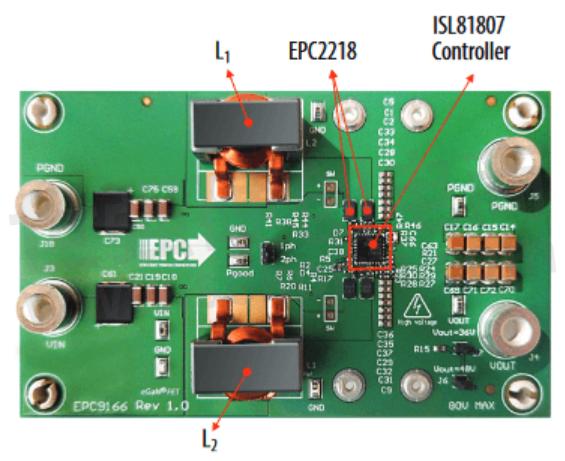How to Design a 12V to 48V Boost Converter Using EGaN FETs and the Renesas ISL81807 Controller?

48V is being adopted in many applications, including AI systems, data centers, and mild hybrid electric vehicles. However, the conventional 12V ecosystem is still dominant, so a high power density 12V to 48V boost converter is required. The fast-switching speed and low RDS(on) of eGaN® FETs can help address this challenge. In this post, the design of a 12V to 48V, 500 W DC-DC power module using eGaN FETs directly driven by eGaN FET compatible ISL81807 controller IC from Renesas in the simple and low-cost synchronous boost topology is evaluated.
Design of a 2-phase eGaN FET-based synchronous boost converter
The multi-phase synchronous boost topology, shown in Figure 1, is popular in DC-DC step-up converter design for its simplicity, ease in control, and low cost.

Figure 1: Simplified schematic block diagram of the EPC9166 eGaN FET-based synchronous boost converter
In this design, the 100V rated EPC2218 with RDS(on) of 3mΩ is selected for the 12V to 48V, 500W power stage. The ISL81807 is an 80V boost controller that can drive eGaN FET directly. Compared to a digital controller solution, the analog controller solution does not need the driver IC, current sense IC, housekeeping power IC, and thus dramatically reduces complexity and Bill of Material (BOM) count. The controller employs current mode control with full protection features such as UVLO and over-current protection. The ISL81807 also allows the designer to choose between constant current mode (CCM) or diode emulation to improve light-load efficiency. The converter's switching frequency is set at 500kHz, and a 2μH inductor (SER2011-202 Coilcraft) with 1.3mΩ DCR and 37A saturation current is chosen.
Design Validation
The EPC9166 synchronous boost converter is shown in Figure 2. The switch-node voltage v SW waveform at 5A output current is shown in Figure 3; the switching is seen to be fast and clean. The overall power efficiency and power loss of the synchronous boost converter are shown in Figure 4, with a peak efficiency of 96.6% at 12V input and 48V output.

Figure 2: Photo of the EPC9166 synchronous boost converter designed for 12V to 60V, 500W operation

Figure 3: Switch-node voltage vSW waveform at 5 A output current.

Figure 4: Total system efficiency and loss of the EPC9166 operating at 12 V input and various output voltages.
Thermal Performance
The thermal image of the converter operating at 12V to 48V, 10A output current with moderate cooling (around 400 LFM forced air cooling) is shown in Figure 5. A temperature rise of 72°C is observed. The board can deliver 480W power without a heatsink.
Conclusion
The EPC9166, an eGaN FET-based 2-phase synchronous boost converter designed around the ISL81807 controller, is introduced. At 12V input and 48V output, it can deliver 500W and achieves 96.6% peak efficiency and 72°C temperature rise with moderate cooling. The whole solution comprises four eGaN FETS with a total die size of only 27.3 mm2. The introduction of eGaN compatible IC ISL81807 can drive eGaN FETs directly by integrating the gate drivers, controller, housekeeping power, and current sense amplifier function in a single chip, which significantly reduced the complexity and cost.

- +1 Like
- Add to Favorites
Recommend
- Sharge Selects GaN FETs EPC2218 from EPC for High-power USB PD Charger Retro 67 to Achieve the Most Efficient Power Conversion
- New Automotive Qualified GaN FETs EPC2204A and EPC2218A for Vehicle Electronics and Advanced Autonomy from EPC
- Design Higher Resolution Lidar Systems with New Automotive-Qualified GaN FET EPC2252 for Advanced Autonomy from EPC
- EPC Introduces EPC9157 48V to 12V Demo Board Featuring EPC eGaN FETs and New Renesas DC-DC Controller
- BRC Solar Selects EPC 100V eGaN FETs for Next Generation Solar Optimizer
- EPC GaN FETs Deliver Benchmark Power Density and Efficiency for DC/DC Conversion
- EPC Introduces a 12V – 48V 500W GaN Boost Converter Demonstration, Offering Superior Efficiency and Power Density
- Automotive AEC Q101 Qualified 65V eGaN FET EPC2219 Enables Higher Resolution for Lidar Systems
This document is provided by Sekorm Platform for VIP exclusive service. The copyright is owned by Sekorm. Without authorization, any medias, websites or individual are not allowed to reprint. When authorizing the reprint, the link of www.sekorm.com must be indicated.

























































































































































































































































































































































































































































































































































































































































































































































































































